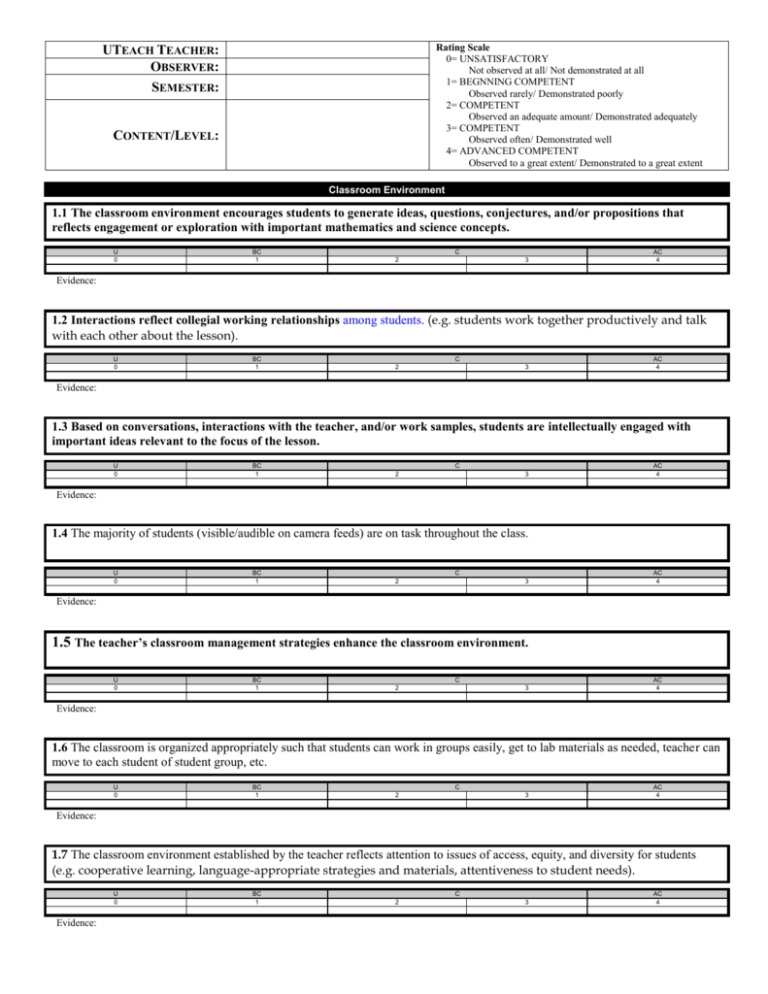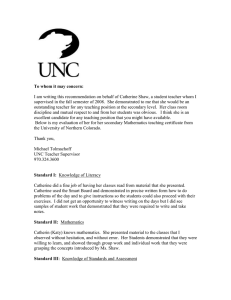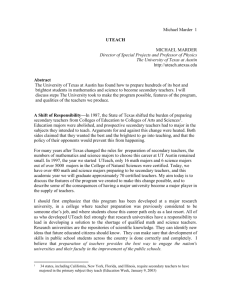Mid Semester Evaluation
advertisement

Rating Scale 0= UNSATISFACTORY Not observed at all/ Not demonstrated at all 1= BEGNNING COMPETENT Observed rarely/ Demonstrated poorly 2= COMPETENT Observed an adequate amount/ Demonstrated adequately 3= COMPETENT Observed often/ Demonstrated well 4= ADVANCED COMPETENT Observed to a great extent/ Demonstrated to a great extent UTEACH TEACHER: OBSERVER: SEMESTER: CONTENT/LEVEL: Classroom Environment 1.1 The classroom environment encourages students to generate ideas, questions, conjectures, and/or propositions that reflects engagement or exploration with important mathematics and science concepts. U 0 BC 1 C 2 3 AC 4 Evidence: 1.2 Interactions reflect collegial working relationships among students. (e.g. students work together productively and talk with each other about the lesson). U 0 BC 1 C 2 3 AC 4 Evidence: 1.3 Based on conversations, interactions with the teacher, and/or work samples, students are intellectually engaged with important ideas relevant to the focus of the lesson. U 0 BC 1 C 2 3 AC 4 Evidence: 1.4 The majority of students (visible/audible on camera feeds) are on task throughout the class. U 0 BC 1 C 2 3 AC 4 Evidence: 1.5 The teacher’s classroom management strategies enhance the classroom environment. U 0 BC 1 C 2 3 AC 4 Evidence: 1.6 The classroom is organized appropriately such that students can work in groups easily, get to lab materials as needed, teacher can move to each student of student group, etc. U 0 BC 1 C 2 3 AC 4 Evidence: 1.7 The classroom environment established by the teacher reflects attention to issues of access, equity, and diversity for students (e.g. cooperative learning, language-appropriate strategies and materials, attentiveness to student needs). U 0 Evidence: BC 1 C 2 3 AC 4 Lesson Structure 2.1 The lessons are well organized and structured (e.g. the objectives of the lesson were clear to students, and the sequence of the lesson was structured to build understanding and maintain a sense of purpose). U 0 BC 1 C 2 3 AC 4 Evidence: 2.2 The structure of the lessons allows students to engage with or explore important concepts in mathematics or science (instead of focusing on techniques that may only be useful on exams). U 0 BC 1 C 2 3 AC 4 Evidence: 2.3 The structure of the lessons includes opportunities for the instructor to gauge student understanding. U 0 BC 1 C 2 3 AC 4 Evidence: 2.4 The lessons include an investigative or problem-based approach to important concepts in mathematics or science. U 0 BC 1 C 2 3 AC 4 3 AC 4 Evidence: 2.5 The teacher obtains and employs resources appropriate for the lesson. U 0 BC 1 C 2 Evidence: 2.6 The teacher is critical and reflective about his/her practice after the lesson, recognizing the strengths and weaknesses of their instruction. U 0 Evidence: BC 1 C 2 3 AC 4 Implementation 3.1 The teacher uses questioning strategies to develop skills and facilitate interaction with students. U 0 BC 1 C 2 3 AC 4 Evidence: 3.2 The teacher’s questioning strategies develop student conceptual understanding of important mathematics or science content (e.g. emphasizing higher order questions, appropriately using “wait time,” exploring incorrect answers). U 0 BC 1 C 2 3 AC 4 Evidence: 3.3 The teacher involves all students in the lesson (calling on non-volunteers, facilitating student-student interaction, checking in with hesitant learners, etc.). U 0 BC 1 C 2 3 AC 4 Evidence: 3.4 The teacher uses formative assessment effectively to be aware of the progress of all students. U 0 BC 1 C 2 3 AC 4 Evidence: 3.5 The teacher modifies the lesson appropriately when formative assessment demonstrates that students did not understand. U 0 BC 1 C 2 3 AC 4 3 AC 4 Evidence: 3.6 An appropriate amount of time is devoted to each part of the lesson. U 0 BC 1 C 2 Evidence: 3.7 The instructional strategies and activities used in this lesson clearly connect to students’ prior knowledge and experience. U 0 BC 1 C 2 3 AC 4 Evidence: 3.8 The teacher's instructional strategies include safe, environmentally appropriate, and ethical implementation of laboratory procedures and/or classroom activities. U 0 Evidence: BC 1 C 2 3 AC 4 Content 4.1 The mathematics or science content chosen is significant, worthwhile, and developmentally appropriate for this course (includes content standards covered, as well as examples and activities chosen by teacher). U 0 BC 1 C 2 3 AC 4 Evidence: 4.2 Content communicated through direct and non-direct instruction by the teacher is consistent with deep knowledge and fluency with the mathematics or science concepts of the lesson (e.g. fluent use of examples, discussions and explanations of concepts, etc.). U 0 BC 1 C 2 3 AC 4 3 AC 4 Evidence: 4.3 Teacher written and verbal content information is accurate. U 0 BC 1 C 2 Evidence: 4.4 Formal assessments used by teacher (if available) are consistent with content objectives (homework, lab sheets, tests, quizzes, etc.). U 0 BC 1 C 2 3 AC 4 Evidence: 4.5 Elements of mathematical/scientific abstraction (e.g., symbolic representations, theory building) are used appropriately. U 0 BC 1 C 2 3 AC 4 3 AC 4 Evidence: 4.6 During the lesson, it is made explicit to students why the content is important to learn. U 0 BC 1 C 2 Evidence: 4.7 Appropriate connections are made to other areas of mathematics or science and to other disciplines (including non-school contexts). U 0 BC 1 C 2 3 AC 4 Evidence: 4.8 During the lesson, there is discussion about the content topic’s role in history or current events. U 0 Evidence: BC 1 C 2 3 AC 4










